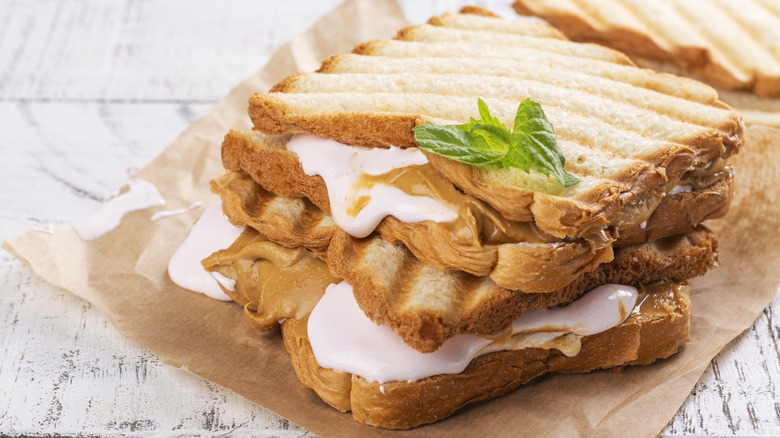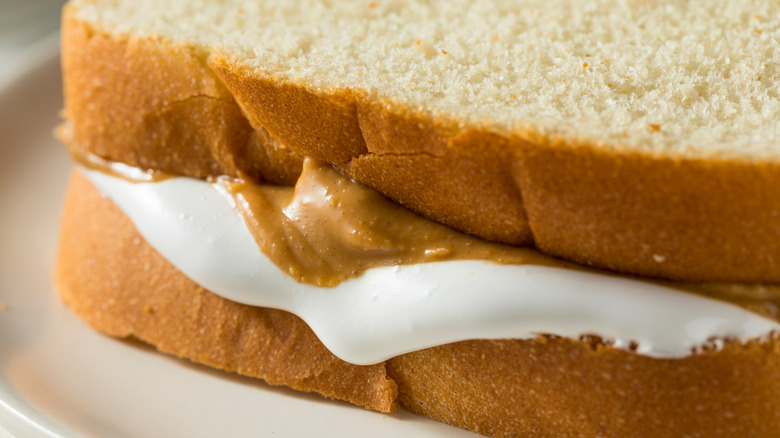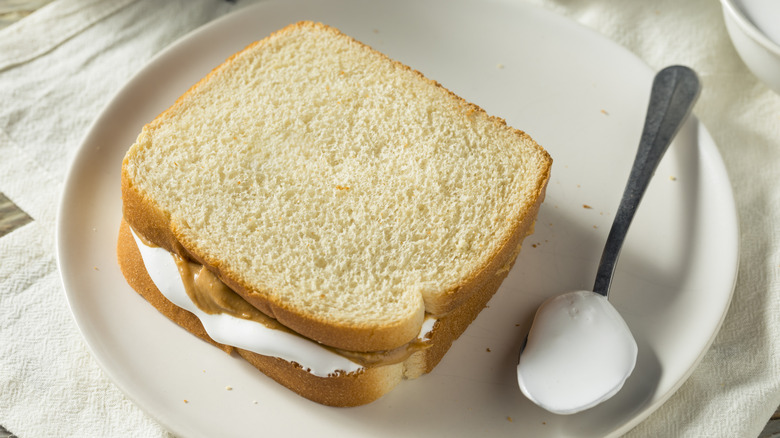The New England Origins Of The Iconic Fluffernutter Sandwich
Across the world, people are scarfing sandwiches, and in the United States, each region has its own unique bread-based creations. Some of these local bites are substantial, like the iconic Philly cheesesteak, but others are significantly less weighty. One recipe from New England could possibly be the most basic sandwich in the United States' regional repertoire: the fluffernutter.
The fluffernutter sandwich has been around for over a century. It was first invented during World War I to help families make the most out of meager, rationed food supplies. To fix yourself a fluffernutter, all you need to do is spread peanut butter and Marshmallow Fluff between two slices of bread. The first mass-marketed marshmallow creme was made in 1913 by Emma Curtis with her brother Amory, just before the global conflict began, and after a few years, Curtis would publish a fluffernutter recipe. Despite its wartime genesis, the fluffernutter is still enjoyed today, primarily in its geographical birthplace in the northeast.
Fluffernutters feed a nation at war
Another candy creator, Archibald Query, put out his marshmallow creme a few years after Curtis, though the two mallow makers were not aware of one another. When World War I rolled around, sugar was suddenly scarce, and Query sold his formula to business partners H. Allen Durkee and Fred L. Mower. Decades later, Durkee-Mower gave us the earliest iteration of Marshmallow Fluff. The first fluffernutter recipe was put out by Emma Curtis in 1918, five years after she and her brother marketed the first marshmallow creme. The original sandwich closely resembled the simple sweet and salty creation we know today, though it was called the Liberty sandwich at the time. Peanut butter is an excellent vegetarian protein source, so it made sense when meat was scarce due to the conflict.
Perhaps most importantly, Curtis' recipe centers around war bread. One of the hardest ingredients to come by during World War I was wheat, and war bread was a catchall term to describe bread baked with an alternative type of flour. The war caused a wheat shortage in Europe, which made feeding the four million men overseas difficult for the U.S. government.
The fluffernutter finds itself after the war
As you've likely ascertained, the nutter part of the name fluffernutter comes from peanut butter, the other spread found in the sandwich. In New England, it remains on the menu. In fact, the fluffernutter is so beloved in the region that in 2006, state officials took an entire week to debate whether or not it should be the official sandwich of Massachusetts. Folks can also get their fluff fill on October 8th, National Fluffernutter Day.
When you consider the sandwich's origin story, you'll understand why the playful name fluffernutter didn't emerge until the 1960s. Mallow marketers in the 1950s realized the effectiveness of marketing to children. Durkee-Mower, the team behind Marshmallow Fluff (the go-to brand for a fluffernutter), coined the term. The company began churning out commercials meant to assuage any guilt felt by mothers over-feeding the sugary spread to children, contending that the sandwich is made much more nutritious by including the protein of peanut butter. After all, you can make other things with Marshmallow Fluff. If you're feeling so inclined, you can even make your own fluff from store-bought marshmallows. Though folks in New England no longer have to ration food, the fluffernutter allows people to devour sweet sandwiches while simultaneously getting a culinary experience with deep historical roots.


